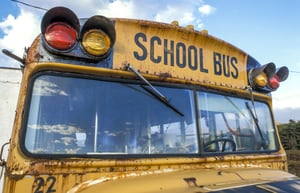Four Reasons to Replace Aging School Buses
published on May 17, 2019 by Sonia Mastros
school bus safety, school bus fleet optimization, School Bus Fleet Management
 School buses are extremely expensive, and represent a huge investment for any school district which has purchased a fleet. It's entirely understandable that a district would want to get the most possible use out of their buses. However, nothing escapes the ravages of time, and at some point any school bus will outlive its usefulness.
School buses are extremely expensive, and represent a huge investment for any school district which has purchased a fleet. It's entirely understandable that a district would want to get the most possible use out of their buses. However, nothing escapes the ravages of time, and at some point any school bus will outlive its usefulness.
Pitching a major fleet upgrade can be an uphill battle, but sometimes it's simply necessary. Or, at least, the cost-benefit analysis points towards old buses being too much of a liability. Here are some big warning signs that those older buses should probably be replaced.
Four Signs You Should Considering Replacing Your Older School Buses
1. The Onboard Electronics Are Beginning to Fail
Vehicles made in the 1980s and 90s, in particular, aren't known for having robust onboard electronics. They are going to be prone to fail as time goes on, and become extremely expensive to replace. Worse, faulty electronics can create serious fire hazards! It's usually not worth the cost to keep buses running when this starts happening.
2. Maintenance Costs Are Creeping Up
Beyond the electronics, any older bus will tend towards needing more and more maintenance as time goes on. Do you track your yearly maintenance costs per bus? It's not hard to run a report and see what direction the trends are pointing. Past a point, they simply become a money hole, and money spent patching them up should probably be spent on upgrades instead.
3. You Want Better Fuel Efficiency and\or Eco-Friendliness
The last couple decades have seen huge revolutions in bus engines, their efficiency, and the potential to use alternative fuels. When you take an older gas-guzzling maintenance-heavy bus and replace it with a model that runs cleaner, better, and will require less maintenance, that turns into big cost savings within 5-10 years.
Plus, it opens up the potential to qualify for various government-sponsored incentives to upgrade to eco-friendly buses, and that can significantly offset upgrade costs.
4. Your Buses Lack Desired Safety Features
Modern buses tend to have a wide range of additional safety features that weren't common in decades past. These include more lights, better driver feedback systems, electronics integration such as GPS systems, and potentially seatbelts. Yes, most of these can be retrofitted onto existing buses, but the upgrade costs can be steep. Combined with running maintenance costs, replacing the bus is often a better option for an all-in-one safety upgrade.
Has your district recently upgraded some or all of its buses? If so, what was the deciding factor that convinced you to take the plunge? Share your experiences in the comments below!



